A Multivariate Statistics-Based Approach for Detecting Diesel Engine Faults with Weak Signatures
Abstract
1. Introduction
2. Engine Fault Detection Using Univariate Statistics
2.1. Description of the Engine Test Cell
2.2. Detecting Engine Faults with Weak Signatures Using Univariate Statistics
3. A Multivariate Statistics-Based Fault Detection Approach of Diesel Engine
3.1. Principal Component Analysis
3.2. Fault Detection Indices
3.3. Determining UCLs Using Adaptive Kernel Density Estimation
4. Case Study
5. Conclusions
Author Contributions
Funding
Conflicts of Interest
References
- Liu, R.; Yang, B.; Zio, E.; Chen, X. Artificial intelligence for fault diagnosis of rotating machinery: A review. Mech. Syst. Signal. Process. 2018, 108, 33–47. [Google Scholar] [CrossRef]
- Haghani, A.; Jeinsch, T.; Roepke, M.; Ding, S.; Weinhold, N. Data-driven monitoring and validation of experiments on automotive engine test beds. Control Eng. Pract. 2016, 54, 27–33. [Google Scholar] [CrossRef]
- Svard, C.; Nyberg, M.; Frisk, E.; Krysander, M. Autimotive engine FDI by application of an automated model-based and data-driven design methodology. Control Eng. Pract. 2013, 21, 455–472. [Google Scholar] [CrossRef]
- Salehi, R.; Alasty, A.; Shahbakhti, M.; Vossoughi, G. Detection and isolation of faults in the exhaust path of turbocharged automotive engines. Int. J. Automot. Technol. 2015, 16, 127–138. [Google Scholar] [CrossRef]
- Boulkroune, B.; Aitouche, A.; Cocquempot, V.; Cheng, L.; Peng, Z. Actuator fault diagnosis with application to a diesel engine testbed. Math. Probl. Eng. 2015, 2015, 189860. [Google Scholar] [CrossRef]
- Mohammadpour, J.; Franchek, M.; Grigoriadis, K. A survey of diagnostic methods for automotive engines. Ind. J. Engine Res. 2011, 13, 41–64. [Google Scholar] [CrossRef]
- Zhong, J.; Wong, P.; Yang, Z. Fault diagnosis of rotating machinery based on multiple probabilistic classifiers. Mech. Syst. Signal. Process. 2018, 108, 99–114. [Google Scholar] [CrossRef]
- Pilario, K.; Cao, Y. Canonical variate dissimilarity analysis for process incipient fault detection. IEEE Trans. Ind. Inform. 2018, 12, 5308–5315. [Google Scholar] [CrossRef]
- Samuel, R.; Cao, Y. Nonlinear process fault detection and identification using kernel PCA and kernel density estimation. Syst. Sci. Control Eng. 2016, 4, 165–174. [Google Scholar] [CrossRef]
- Jiang, Q.; Yan, X.; Huang, B. Performance-driven distributed PCA process monitoring based on fault-relevant variable selection and Bayesian inference. IEEE Trans. Ind. Electron. 2015, 63, 377–386. [Google Scholar] [CrossRef]
- Zhang, K.; Ding, S.; Shardt, Y.; Sarrate, Y.; Chen, Z.; Peng, K. Assessment of T2 and Q statistics for detecting additive and multiplicative faults in multivariate statistical process monitoring. J. Frankl. Inst. 2017, 354, 668–688. [Google Scholar] [CrossRef]
- Wang, Y.; Si, Y.; Huang, B.; Lou, Z. Survey on the theoretical research and engineering applications of multivariate statistics process monitoring algorithms: 2008–2017. Can. J. Chem. Eng. 2018, 96, 2073–2085. [Google Scholar] [CrossRef]
- Boullosa, D.; Larrabe, J.; Lopez, A.; Gomez, M. Monitoring through T2 Hotelling of cylinder lubrication process of marine diesel engine. Appl. Therm. Eng. 2017, 110, 32–38. [Google Scholar] [CrossRef]
- Boullosa, D.; Barrena, J.; Lopez, A.; Menendez, J.; Solaetxe, M. Monitoring of fuel oil process of marine diesel engine. Appl. Therm. Eng. 2017, 127, 517–526. [Google Scholar] [CrossRef]
- Antory, D. Fault diagnosis application in an automotive diesel engine using auto-associative neural networks. In Proceedings of the International Conference on Computational Intelligence for Modeling, Control and Automation and International Conference on Intelligent Agents, Vienna, Austria, 28–30 November 2005; Volume 2, pp. 109–116. [Google Scholar]
- Zhong, K.; Li, J.; Wang, J.; Han, M. Fault detection for marine diesel engine using semi-supervised principal component analysis. In Proceedings of the 9th International Conference on information Science and Technology, Hulunbuir, China, 2–5 August 2019; pp. 146–151. [Google Scholar]
- Antory, D. Application of a data-driven monitoring technique to diagnose air leaks in an automotive diesel engine: A case study. Mech. Syst. Signal. Process. 2007, 21, 795–808. [Google Scholar] [CrossRef]
- Antory, D.; Kruger, U.; Irwin, G.; McCullough, G. Fault diagnosis in internal combustion engines using non-linear multivariate statistics. Proc. Inst. Mech. Eng. Part I J. Syst. Control Eng. 2005, 219, 243–258. [Google Scholar] [CrossRef]
- Davies, T.; Lawson, A. An evaluation of likelihood-based bandwidth selectors for spatial and spatiotemporal kernel estimates. J. Stat. Comput. Simul. 2019, 89, 1131–1152. [Google Scholar] [CrossRef]
- Heda, K.; Louani, D. Optimal bandwidth selection in kernel density estimation for continuous time dependent processes. Stat. Probab. Lett. 2018, 138, 9–19. [Google Scholar] [CrossRef]
- Yadav, R.; Raj, S.; Pradhan, A. Real-time event classification in power system with renewables using kernel density estimation and deep neural network. IEEE Trans. Smart Grid 2019, 10, 6849–6859. [Google Scholar] [CrossRef]
- Zhang, F.; Liu, Y.; Chen, C.; Li, Y.; Huang, H. Fault diagnosis of rotating machinery based on kernel density estimation and Kullback-Leibler divergence. J. Mech. Sci. Technol. 2014, 28, 4441–4454. [Google Scholar] [CrossRef]
- Wei, N.; Gu, J.; Gu, F.; Chen, Z.; Li, G.; Wang, T.; Ball, A. An investigation into the acoustic emissions of internal combustion engines with modeling and wavelet package analysis for monitoring lubrication conditions. Energies 2019, 12, 640. [Google Scholar] [CrossRef]
- Li, G.; Gu, F.; Wang, T.; Lu, X.; Zhang, L.; Zhang, C.; Ball, A. An improved lubrication model between piston rings and cylinder liners with consideration of liner dynamic deformations. Energies 2017, 10, 2122. [Google Scholar] [CrossRef]
- Samuel, R.; Cao, Y. Fault detection in a multivariate process based on kernel PCA and kernel density estimation. In Proceedings of the 20th Inernational Conference on Automation and Computing, Cranfield, UK, 12–13 September 2014; pp. 146–151. [Google Scholar]
- Alcala, C.; Qin, S. Analysis and generalization of fault diagnosis methods for process monitoring. J. Process Control 2011, 21, 322–330. [Google Scholar] [CrossRef]
- Norvilas, A.; Negiz, A.; DeCicco, J.; Cinar, A. Intelligent process monitoring by interfacing knowledge-based systems and multivariate statistical monitoring. J. Process Control 2000, 10, 341–350. [Google Scholar] [CrossRef]
- Dunia, R.; Qin, S. Subspace approach to multidimensional fault identification and reconstruction. AICHE J. 1998, 44, 1813–1831. [Google Scholar] [CrossRef]
- Rao, B. Nonparametric Functional Estimation; Academic Press: New York, NY, USA, 2014. [Google Scholar]
- Cao, R.; Cuevas, A.; Manteiga, W. A comparative study of several smoothing methods in density estimation. Comput. Stat. Data Anal. 1994, 17, 153–176. [Google Scholar] [CrossRef]
- Au, S.; Beck, J. A new adaptive importance sampling scheme for reliability calculations. Struct. Saf. 1999, 21, 135–158. [Google Scholar] [CrossRef]
- Abramson, I. On bandwidth variation in kernel estimates—A square root law. Ann. Stat. 1982, 10, 1217–1223. [Google Scholar] [CrossRef]
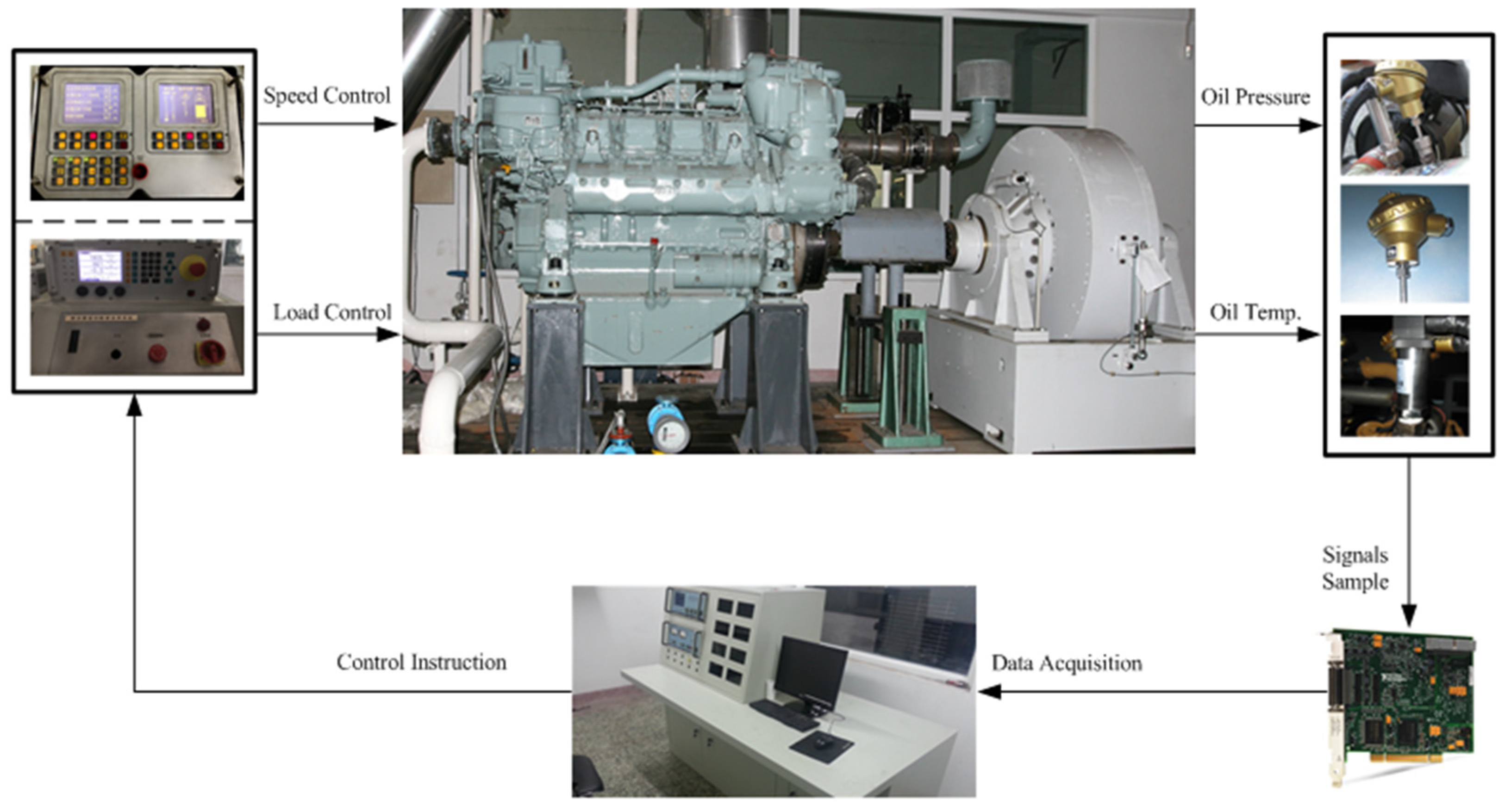
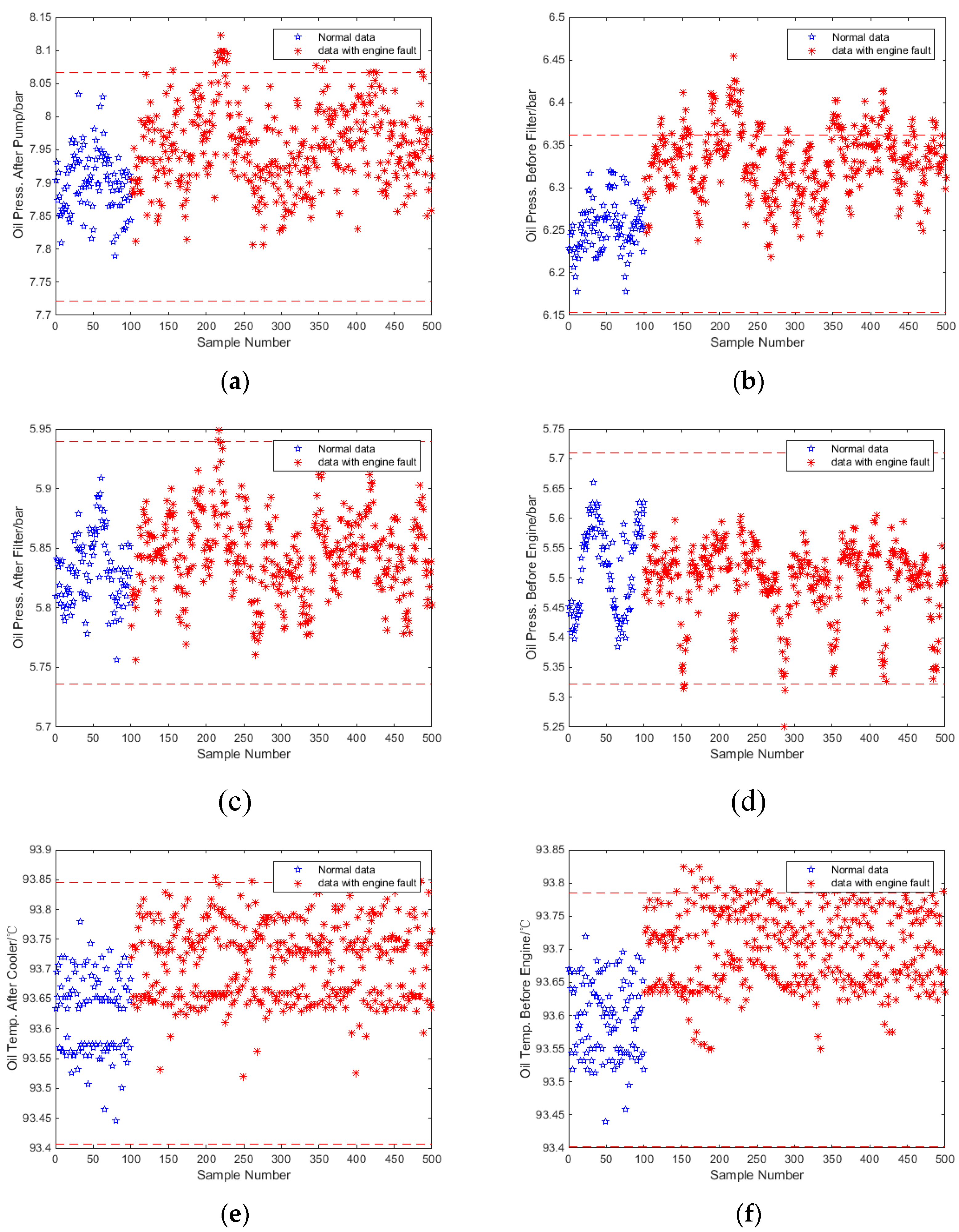
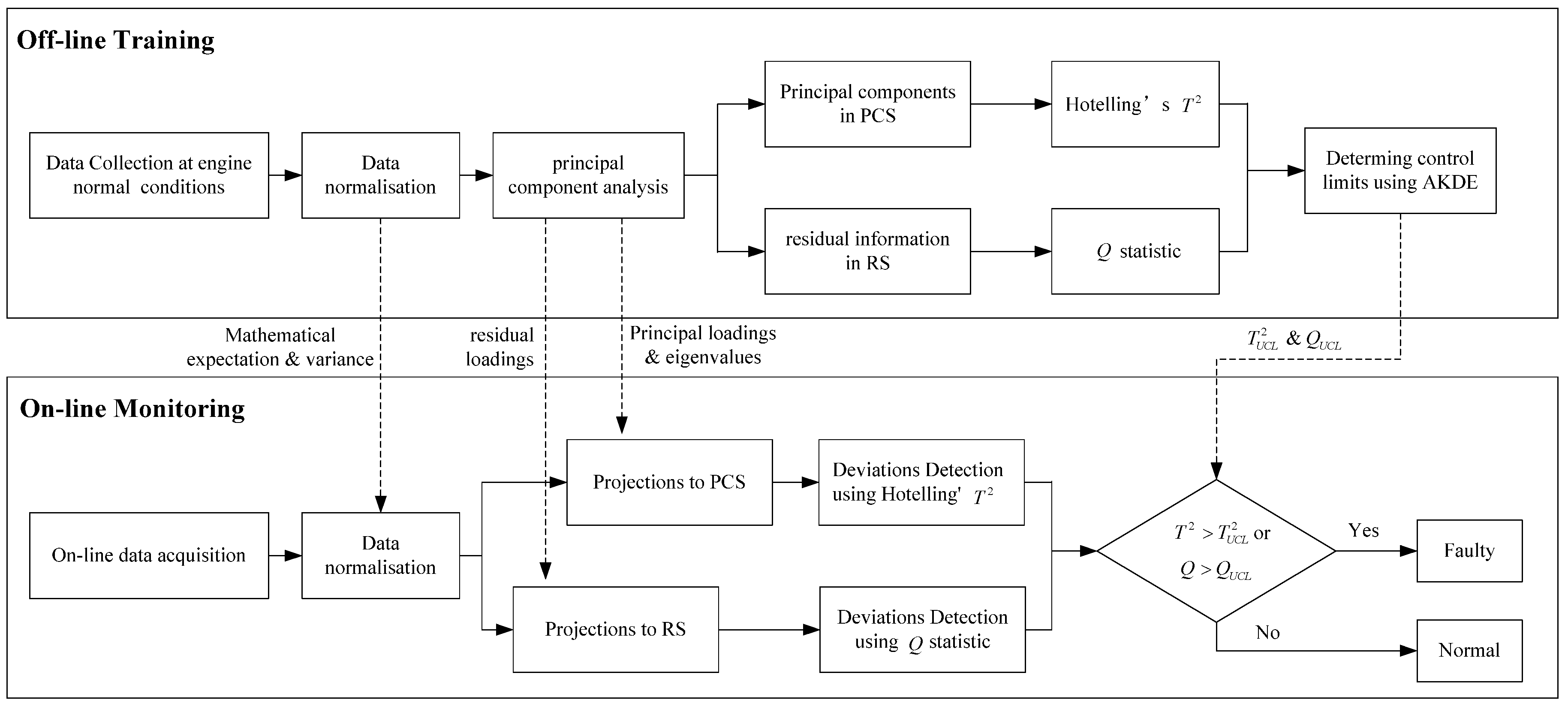
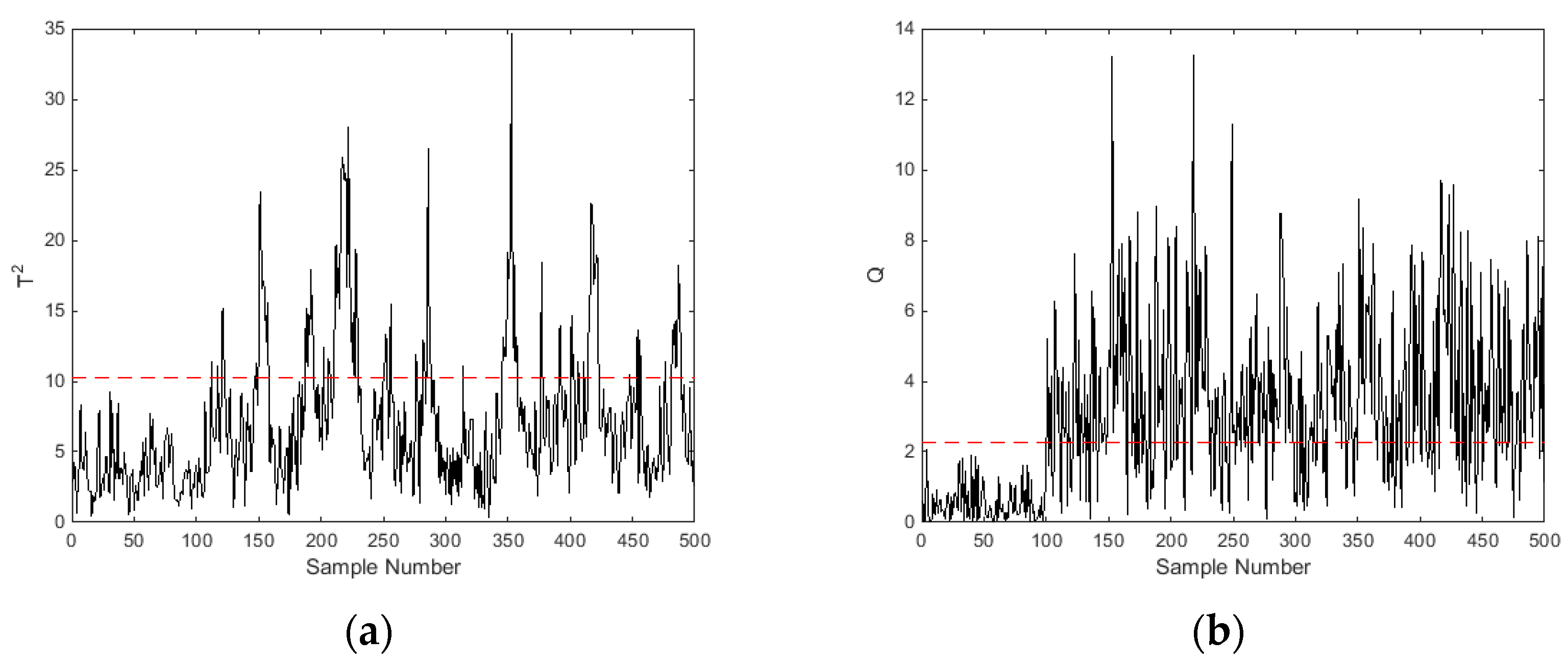
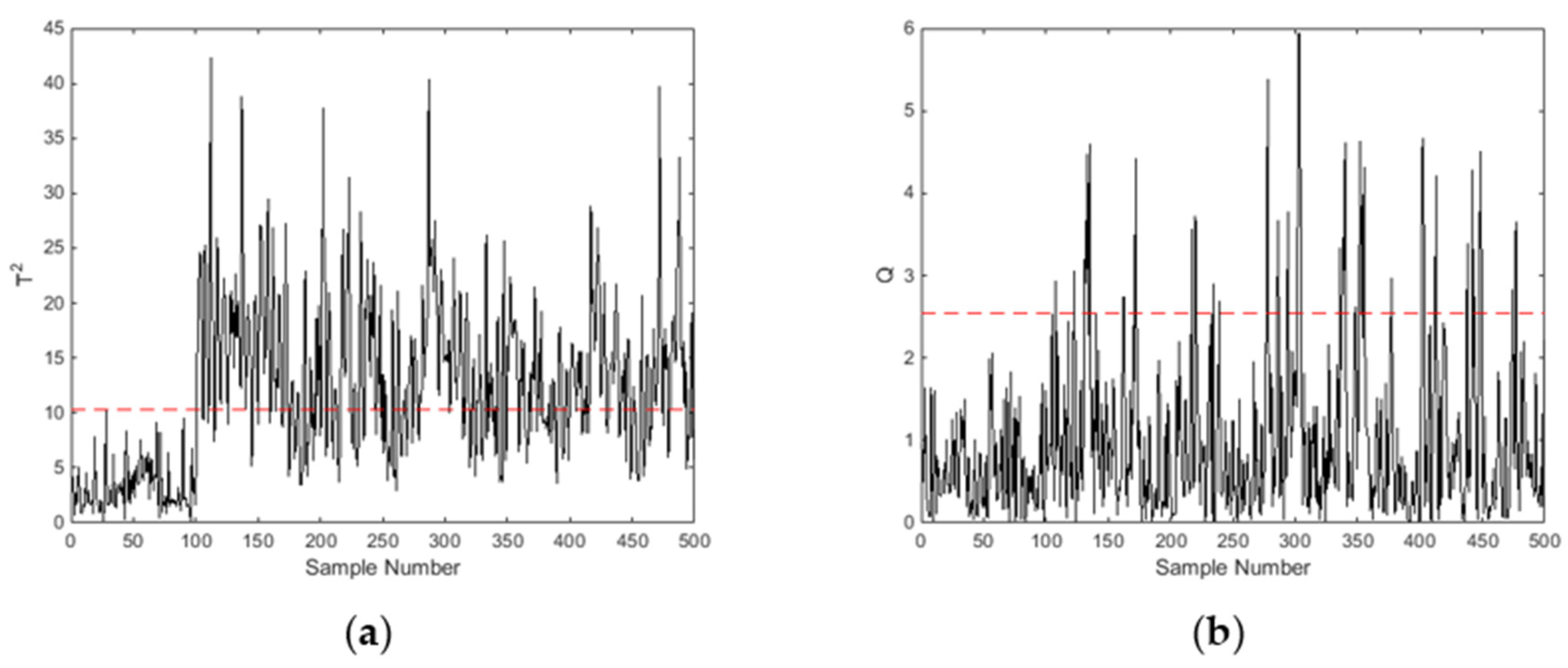
| Specifications | Unit | Parameters |
|---|---|---|
| Model | - | MTU8V396SE84 |
| Cycle | - | High-speed 4-stroke |
| Number of Cylinders | - | 8 |
| Bore | mm | 165 |
| Stroke | mm | 185 |
| Compression Ratio | - | 12.3 |
| Engine Maximum Output | kW | 500 at 1800 rpm |
| Idle Speed | rpm | 600 |
| Rated speed | rpm | 1800 |
| Number | Engine Parameters | Unit |
|---|---|---|
| 1 | Oil pressure after pump | bar |
| 2 | Oil pressure before filter | bar |
| 3 | Oil pressure after filter | bar |
| 4 | Oil pressure before engine | bar |
| 5 | Oil temperature after cooler | °C |
| 6 | Oil temperature before engine | °C |
| Loads and Speeds | Engine Health Conditions | Working Parameters | |||||
|---|---|---|---|---|---|---|---|
| Oil Pressure after Pump/bar | Oil Pressure before Filter/bar | Oil Pressure after Filter/bar | Oil Pressure before Engine/Bar | Oil Temperature after Cooler/°C | Oil Temperature before Engine/°C | ||
| 25%, 1800 rpm | Healthy | 8.03 | 6.32 | 5.94 | 5.65 | 85.66 | 85.44 |
| Oil leakage | 7.94 | 6.22 | 5.85 | 5.60 | 85.76 | 85.52 | |
| Oil filter clogging | 8.17 | 6.45 | 5.92 | 5.61 | 85.81 | 85.53 | |
| Low oil level | 7.95 | 6.29 | 5.92 | 5.60 | 85.91 | 85.60 | |
| 50%, 1800 rpm | Healthy | 7.99 | 6.28 | 5.90 | 5.59 | 88.68 | 88.50 |
| Oil leakage | 7.87 | 6.20 | 5.81 | 5.50 | 88.99 | 88.84 | |
| Oil filter clogging | 8.03 | 6.34 | 5.89 | 5.57 | 88.86 | 88.67 | |
| Low oil level | 7.80 | 6.23 | 5.83 | 5.50 | 89.14 | 88.99 | |
| 75%, 1800 rpm | Healthy | 7.89 | 6.26 | 5.84 | 5.52 | 93.23 | 93.19 |
| Oil leakage | 7.80 | 6.21 | 5.79 | 5.46 | 93.49 | 93.40 | |
| Oil filter clogging | 7.95 | 6.33 | 5.82 | 5.49 | 93.74 | 93.71 | |
| Low oil level | 7.80 | 6.19 | 5.80 | 5.46 | 93.87 | 93.72 | |
| Engine Faults | Load and Speed | Pauta Criterion |
|---|---|---|
| Oil leakage | 25%, 1800 rpm | 43% |
| 50%, 1800 rpm | 47.75% | |
| 75%, 1800 rpm | 68.5% | |
| Oil filter clogging | 25%, 1800 rpm | 73.75% |
| 50%, 1800 rpm | 100% | |
| 75%, 1800 rpm | 30.5% | |
| Low oil level | 25%, 1800 rpm | 81.25% |
| 50%, 1800 rpm | 43.75% | |
| 75%, 1800 rpm | 77% |
| Engine Faults | Load and Speed | Pauta Criterion | Multivariate Statistics | Improved Degrees |
|---|---|---|---|---|
| Oil leakage | 25%, 1800 rpm | 43% | 84.75% | 41.75% |
| 50%, 1800 rpm | 47.75% | 69% | 21.25% | |
| 75%, 1800 rpm | 68.5% | 85% | 16.5% | |
| Oil filter clogging | 25%, 1800 rpm | 73.75% | 100% | 26.25% |
| 50%, 1800 rpm | 100% | 100% | 0 | |
| 75%, 1800 rpm | 30.5% | 75.5% | 45% | |
| Low oil level | 25%, 1800 rpm | 81.25% | 99.75% | 18.5% |
| 50%, 1800 rpm | 43.75% | 85% | 41.25% | |
| 75%, 1800 rpm | 77% | 82.25% | 5.25% |
© 2020 by the authors. Licensee MDPI, Basel, Switzerland. This article is an open access article distributed under the terms and conditions of the Creative Commons Attribution (CC BY) license (http://creativecommons.org/licenses/by/4.0/).
Share and Cite
Wang, J.; Zhang, C.; Ma, X.; Wang, Z.; Xu, Y.; Cattley, R. A Multivariate Statistics-Based Approach for Detecting Diesel Engine Faults with Weak Signatures. Energies 2020, 13, 873. https://doi.org/10.3390/en13040873
Wang J, Zhang C, Ma X, Wang Z, Xu Y, Cattley R. A Multivariate Statistics-Based Approach for Detecting Diesel Engine Faults with Weak Signatures. Energies. 2020; 13(4):873. https://doi.org/10.3390/en13040873
Chicago/Turabian StyleWang, Jinxin, Chi Zhang, Xiuzhen Ma, Zhongwei Wang, Yuandong Xu, and Robert Cattley. 2020. "A Multivariate Statistics-Based Approach for Detecting Diesel Engine Faults with Weak Signatures" Energies 13, no. 4: 873. https://doi.org/10.3390/en13040873
APA StyleWang, J., Zhang, C., Ma, X., Wang, Z., Xu, Y., & Cattley, R. (2020). A Multivariate Statistics-Based Approach for Detecting Diesel Engine Faults with Weak Signatures. Energies, 13(4), 873. https://doi.org/10.3390/en13040873





